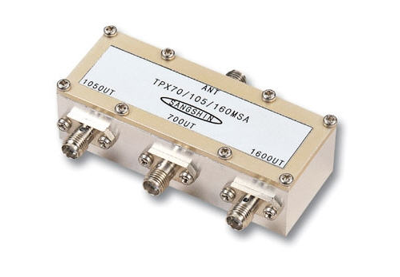triplexer
A triplexer is an electronic circuit that divides an incoming signal into three signals based on frequency or wavelength. A triplexer can be frequency-based, like two diplexers, i.e. like crossovers, or wavelength-based, dividing an optical signal by its wavelength into three optical signals with different wavelengths.
Frequency triplexers are a combination of low pass( TP), high pass( HP) and band pass( BP). The received frequency is frequency-divided by low-pass, high-pass, band-pass and band-stop filters and fed to three different outputs. For example, an antenna signal can be filtered out with a triplexer via a high-pass filter for the UHF range for frequencies between 470 MHz and 862 MHz. Furthermore, a low-pass filter with downstream bandpass filters can be used to filter out signals for FM broadcasting between 88 MHz and 108 MHz and for T-DAB the frequency range between 217 MHz and 230 MHz. Like diplexers, triplexers are also available as tiny LTCC packages.
Optical triplexers are used in passive optical networks( PON), in EPON, gigabit PON( GPON) and BPON, and in optical connectivity with FTTx technology. But they are also used in wavelength division multiplexing(WDM), where they divide optical signals into wavelengths of 1,310 nm, 1,490 nm and 1,550 nm.

